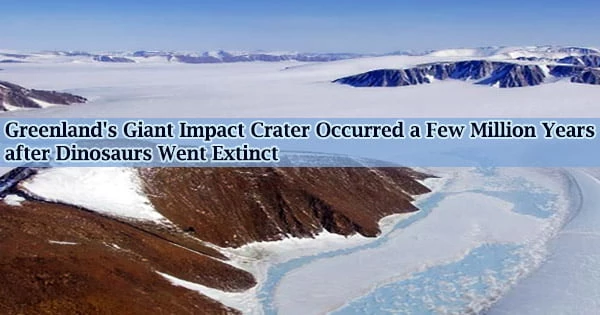Danish and Swedish experts have dated the massive Hiawatha impact crater, a 31 km-wide meteorite crater buried beneath a kilometer of Greenlandic ice. The discovery puts to rest suspicions that the meteorite struck after humans appeared, and also sheds new light on Earth’s post-dinosaur evolution.
Since 2015, when geologists from the University of Copenhagen’s GLOBE Institute found the Hiawatha impact crater in northeastern Greenland, there has been much conjecture over the crater’s age.
Could the asteroid have collided with Earth as early as 13,000 years ago, when humanity had already established themselves on the planet?
Could its impact have triggered the Younger Dryas, a roughly 1,000-year period of global cooling?
The answer is no, according to new research conducted by the Natural History Museum of Denmark, the GLOBE Institute at the University of Copenhagen, and the Swedish Museum of Natural History in Stockholm on grains of sand and pebbles from the Hiawatha impact crater.
Dating the crater has been a particularly tough nut to crack, so it’s very satisfying that two laboratories in Denmark and Sweden, using different dating methods arrived at the same conclusion. As such, I’m convinced that we’ve determined the crater’s actual age, which is much older than many people once thought.
Michael Storey
The impact crater Hiawatha is much older. In reality, according to a new study published today in the journal Science Advances, it is 58 million years old.
“Dating the crater has been a particularly tough nut to crack, so it’s very satisfying that two laboratories in Denmark and Sweden, using different dating methods arrived at the same conclusion. As such, I’m convinced that we’ve determined the crater’s actual age, which is much older than many people once thought,” says Michael Storey of the Natural History Museum of Denmark.
“Determining the new age of the crater surprised us all. In the future, it will help us investigate the impact’s possible effect on climate during an important epoch of Earth’s history,” says Dr. Gavin Kenny of the Swedish Museum of Natural History.
Professor Nicolaj Krog Larsen of the GLOBE Institute at the University of Copenhagen, who was one of those who helped locate the Hiawatha impact crater in 2015, is glad that the crater’s exact age has finally been validated.
“It is fantastic to now know its age. We’ve been working hard to find a way to date the crater since we discovered it seven years ago. Since then, we have been on several field trips to the area to collect samples associated with the Hiawatha impact,” says Professor Larsen
Age revealed by laser beams and grains of sand
When the Hiawatha asteroid slammed into Earth’s surface, producing several million times the energy of an atomic bomb, no kilometer-thick ice sheet blanketed Northwest Greenland.
At the time, the Arctic was covered with a temperate rainforest, there was plenty of wildlife, and temperatures hovered about 20 degrees Celsius. A far larger asteroid slammed present-day Mexico eight million years ago, causing the demise of Earth’s dinosaurs.
The asteroid collided with Earth, creating a 31-kilometer-wide and one-kilometer-deep crater. The crater is large enough to hold Washington, D.C. in its entirety. The crater is now submerged beneath the Hiawatha Glacier in Northwest Greenland.
Rivers flowing from the glacier provided sand and pebbles that had been superheated by the 58 million-year-old collision.
The sand was tested by burning the grains with a laser until they emitted argon gas, while the rock samples were analyzed by uranium-lead dating of the mineral zircon at the Swedish Museum of Natural History.
There is currently no conclusive evidence that the Hiawatha impact altered world climate. The crater’s dating, on the other hand, permits the multinational research team working on it to begin testing numerous ideas in order to better comprehend the crater’s impact on the local and global climate.
Facts:
The Hiawatha impact crater is larger than 90 percent of the roughly 200 previously known impact craters on Earth, measuring 31 kilometers across.
Although the Hiawatha impact crater is much smaller than the Chicxulub impact crater in modern-day Mexico, which was responsible for the extinction of the dinosaurs, it would have destroyed the region and possibly had wider implications for climate, plant, and animal life.
The Earth had recovered from the catastrophic impacts of the Chicxulub impact eight million years earlier and was commencing a long-term warming trend that would last around 5 million years when the Hiawatha impact happened 58 million years ago.





